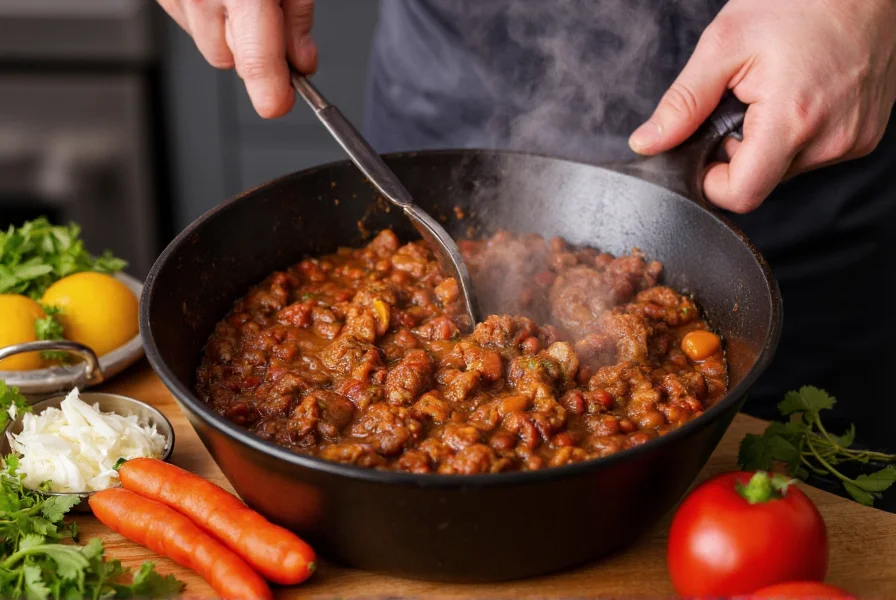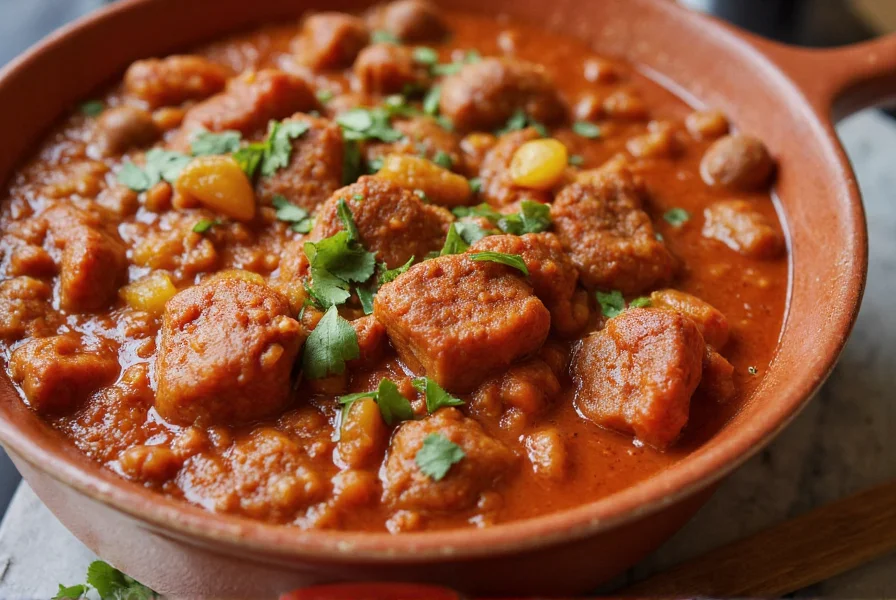For centuries, meat chili has been a cornerstone of American culinary tradition, evolving from its Mesoamerican roots into countless regional variations across the United States. This beloved dish transforms simple ingredients into a complex, satisfying meal through careful layering of flavors and proper cooking techniques.
The Rich History of Meat Chili
Meat chili's origins trace back to pre-Columbian Mesoamerica, where indigenous peoples combined chili peppers with meat. Spanish colonists later introduced European cooking techniques, creating the foundation for modern chili. By the 19th century, chili con carne (chili with meat) became a staple among cowboys, miners, and settlers across the American Southwest.
The dish gained national prominence at the 1893 Chicago World's Fair, where vendors served "chili stands" to enthusiastic crowds. Today, regional variations distinguish themselves through ingredient choices and preparation methods, reflecting local culinary traditions.
Essential Ingredients for Authentic Meat Chili
The foundation of exceptional meat chili starts with quality ingredients. Understanding traditional meat chili ingredients helps create an authentic flavor profile while allowing for personal customization.
| Ingredient Category | Essential Components | Optional Enhancements |
|---|---|---|
| Meat | Ground chuck (80/20), cubed chuck roast, brisket | Smoked bacon, venison, chorizo |
| Chili Peppers | Ancho, guajillo, chipotle in adobo | Fresh jalapeños, serranos, habaneros |
| Spice Blend | Cumin, garlic powder, oregano, black pepper | Cocoa powder, cinnamon, allspice |
| Liquid Base | Tomato paste, beef broth, beer | Worcestershire sauce, coffee, vinegar |
| Beans (Optional) | Kidney beans, pinto beans | Black beans, navy beans |
Step-by-Step Meat Chili Preparation Guide
Creating the perfect meat chili requires attention to detail at each stage of preparation. Follow these steps for a deeply flavorful result:
- Prepare your meat: For ground beef chili recipe success, use freshly ground chuck rather than pre-packaged meat. If using cubed meat, cut into 1/2-inch pieces for even cooking.
- Sear properly: Brown meat in batches without overcrowding the pot. This develops the Maillard reaction, creating complex flavor compounds essential for homemade meat chili from scratch.
- Build flavor layers: After removing meat, sauté onions and garlic until translucent, then add tomato paste and cook until it darkens slightly—this "cooks out" the raw flavor.
- Toast spices: Add dried spices to the oil and tomato mixture, stirring constantly for 30-60 seconds until fragrant. This activates essential oils in the spices.
- Simmer patiently: Return meat to the pot with liquid ingredients. Simmer uncovered for 2-3 hours for ground beef, or 3-4 hours for cubed meat, stirring occasionally. The best meat chili recipes develop flavor through slow cooking.

Regional Meat Chili Variations
Understanding regional meat chili variations helps you appreciate the dish's cultural significance and adapt recipes to your preferences:
- Texas Red: The original meat chili recipe contains only meat, chili peppers, and spices—no beans or tomatoes. This "bowl of red" focuses purely on meat flavor enhanced by dried chili peppers.
- Cincinnati Chili: Served over spaghetti with unique spice profile including cinnamon and cloves, often topped with cheese, onions, and beans.
- New Mexico Style: Features green chili peppers as the primary ingredient with minimal spices, highlighting the fresh pepper flavor.
- Midwest Meat Chili: Typically includes beans, tomatoes, and a balanced spice profile, often served with oyster crackers.
Advanced Meat Chili Cooking Tips
Elevate your meat chili from good to exceptional with these professional techniques:
- Meat selection matters: Use 80/20 ground chuck for optimal fat content. The fat renders during cooking, creating rich flavor while preventing dryness.
- Chili pepper preparation: Toast dried peppers before rehydrating to intensify flavor. Remove seeds for milder heat while retaining flavor.
- Acid balance: Add a splash of vinegar or lime juice at the end of cooking to brighten flavors and balance richness.
- Texture control: For perfect meat chili texture, mash some beans before adding or use a small amount of masa harina to thicken without making the chili gummy.
- Resting period: Let chili rest overnight. This allows flavors to meld and improves overall taste—many professional chefs consider this essential for authentic meat chili.
Serving Suggestions and Accompaniments
Traditional meat chili shines when paired with complementary sides that enhance its rich flavors:
- Cornbread or corn muffins for a classic pairing that soaks up chili beautifully
- Sliced avocado or guacamole to add creaminess that balances heat
- Shredded cheddar or Monterey Jack cheese for added richness
- Finely diced white onions for fresh contrast
- Lime wedges to brighten each serving
- Oyster crackers for texture contrast in Midwest-style preparations

Storage and Reheating Instructions
Proper storage maintains meat chili's quality for future enjoyment:
- Cool chili completely before storing to prevent condensation
- Store in airtight containers for up to 4 days in the refrigerator
- Freeze in portion-sized containers for up to 3 months
- Reheat gently on the stove with a splash of broth to restore moisture
- Avoid microwaving large quantities, which can create uneven heating
Many cooks find that meat chili tastes even better the second day as flavors continue to meld. When reheating, consider adding a pinch of fresh spices to revitalize the flavor profile.
Nutritional Profile of Homemade Meat Chili
A typical serving (1 cup) of traditional meat chili provides:
- Approximately 250-350 calories depending on meat fat content
- 20-25g of high-quality protein from the meat
- 8-12g of dietary fiber when beans are included
- Rich in iron, zinc, and B vitamins from the meat
- Contains capsaicin from chili peppers, which may offer metabolic benefits
What's the difference between meat chili and chili con carne?
Chili con carne is Spanish for 'chili with meat' and refers specifically to the traditional Texas-style meat chili that contains only meat, chili peppers, and spices—no beans or tomatoes. Meat chili is a broader term that includes regional variations with additional ingredients.
Can I make meat chili without beans?
Yes, authentic Texas-style meat chili traditionally contains no beans. Many chili competitions actually prohibit beans in the meat chili category. If you prefer a bean-free version, simply omit them and adjust liquid content slightly to maintain proper consistency.
How do I fix chili that's too spicy?
To reduce excessive heat in meat chili, add dairy products like sour cream or shredded cheese, a small amount of sugar or honey, or acidic elements like lime juice. You can also increase the overall volume by adding more tomatoes or broth. Remember that chili's heat often mellow slightly as it sits overnight.
What's the best cut of meat for chili?
Chuck roast is ideal for cubed meat chili as it contains the right fat-to-meat ratio that becomes tender during slow cooking. For ground beef chili recipe preparation, freshly ground chuck (80/20) provides optimal flavor and texture. Brisket also makes an excellent choice for its rich flavor and connective tissue that breaks down during cooking.
How long should I simmer meat chili for best results?
For ground beef chili, simmer for 2-3 hours uncovered. For cubed meat chili, simmer for 3-4 hours until the meat is fork-tender. The extended cooking time allows flavors to develop fully and creates the perfect meat chili texture. Many chefs recommend making chili a day ahead, as flavors continue to improve with resting time.











 浙公网安备
33010002000092号
浙公网安备
33010002000092号 浙B2-20120091-4
浙B2-20120091-4